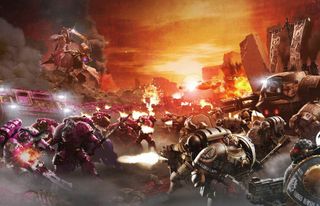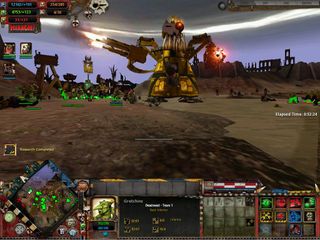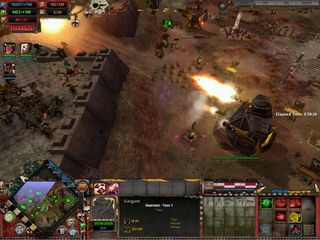Dawn of War's modders have turned it into the ultimate Warhammer 40K game
How an RTS claasic has slowly become the Warhammer 40,000 game we've always dreamed of.

New Ways To Die
Another mod aiming to more accurately represent the tabletop game is Firestorm Over Kaurava, which changes unit stats to more closely resemble official sources, removes flying units, and tones down video game excesses like the ability to reinforce squads away from your own structures. It also spins the sword-wielding crusaders of the Black Templars off from the generic Space Marines into their own force. Not all of the changes are lore-friendly Serious Business, however, as it also lets you field a force of the fan-made Angry Marines or an army covered in plain basecoat because you haven’t got around to painting the miniatures yet.
If you’ve ever set up a skirmish battle in Age Of Empires or the like just to turtle in your base and fight off any attackers who dare approach, you’ll understand the appeal of Survival: The Art Of Defence. While one of Dawn Of War’s design aims was to push players into early conflict by forcing them to squabble over strategic points and relics, the Warhammer 40,000 fiction is full of doomed last stands in which small numbers of Space Marines or Imperial Guard hunker down while endless waves of enemies fall on them, and those are the scenarios Survival recreates. Its maps throw hordes of enemies at you in growing numbers until by the end of it they’re swamping you with vehicles as your last turret’s about to fall. Even when I tried to stack the deck in my favor by choosing the wimpy space-elf Eldar as my opponents (sorry, Eldar fans) they eventually swamped my position with spindly-limbed walkers and laser-spitting Brightlance platforms, breaking my Marines’ morale over and over till they had nowhere left to fall back to.
Ultimate Apocalypse comes closer than anything else to bringing that imaginary game Warhammer 40,00 players dream of to life.
Part of what makes Dawn Of War more appealing than other RTS games (and particularly its sequel) is its scale, putting you in charge of entire squadrons and eventually building up to fleets of tanks that rumble across the terrain. But the tabletop version of Warhammer 40,000 goes even bigger than that in the “Epic” line of games, in which skyscraper-sized mechs called Titans stomp into battle with each other. Only 1997’s turn-based Final Liberation let you control Titans until the Ultimate Apocalypse mod came out.

Ultimate Apocalypse is the end-all of Dawn Of War mods, adding gigantic new troops to the existing armies as well as those of the Tyranids, Daemons, and Daemon Hunters mods (which you’ll need to install first, and I recommend also installing the NTCore executable to give more access to your RAM to reduce the number of crashes). Unstoppable Ork Gargants with belly-cannons and gigantic Imperial god-machines will soon be demolishing all in their path, and it also increases the limit on how far the camera can be zoomed back so that you can actually see these giants in action, pulling skyward so far the entire map is visible. Ultimate Apocalypse removes the cap on how many vehicles you can have, which was the mod’s modest original aim when it began in 2010, and you’ll need plenty more tanks to take down those Titans.
Ultimate Apocalypse also changes the endgame significantly. Whoever sends the first Titan out has the advantage, but doing so puts a huge dent in your power resource and you’ll have to short-change yourself elsewhere to do so. Playing as the Dark Eldar I scrimped and saved to afford a Tormentor Titan, a four-legged mech with a skull face and shoulder-mounted cannon. It was worth it to send that creepy thing out with the troops who used to be my elites scurrying around its base, picking off weaker enemies who approached. But in spending resources on that I’d given my opponents a chance to fill out their own tech trees, which is how I discovered the Tyranids have a game-winning endgame research option called “eat world”.
Ultimate Apocalypse is still being worked on today, with balance and bug fixes the current targets and a single-player campaign on the way. Even in its current state in comes closer than anything else to bringing that imaginary game Warhammer 40,00 players dream of to life, with hundreds of bizarre troops of every shape and kind being thrown at each other and entire worlds at stake.

Returning to vanilla Dawn Of War after modding it to hell and back is an odd experience. I keep trying to pull the camera out further and then realizing what once seemed like a god-like omniscient skyview is actually kind of dinky, but even so the base game’s appeal remains obvious. In 2004 the RTS genre was in an odd place, no longer thriving as it had in the 1990s and starting to change to fight its growing irrelevance. You can see that in Dawn Of War with its meatgrinder battles and necessary twists on resource-gathering—it’s hard to imagine Space Marines collecting crystals to pay for their next round of upgrades—but it’s still recognizable as a classic RTS at heart.
The biggest gaming news, reviews and hardware deals
Keep up to date with the most important stories and the best deals, as picked by the PC Gamer team.
Though it reduces the importance of base-building compared to other games of the era that staple is still there, with pre-fab buildings dropped from orbit to add drama to what the designers obviously realized was a boring element of the genre. Tech trees still need to be unlocked, and racing to build tanks before your opponent is still the best tactic. Dawn Of War is simultaneously a nostalgic look back at the way strategy games used to be and a glimpse at potential directions they could have explored, if only they’d had the chance to do so. Fortunately, thanks to the valiant efforts of modders expanding on that base, now we can see what that might have looked like.

Jody's first computer was a Commodore 64, so he remembers having to use a code wheel to play Pool of Radiance. A former music journalist who interviewed everyone from Giorgio Moroder to Trent Reznor, Jody also co-hosted Australia's first radio show about videogames, Zed Games. He's written for Rock Paper Shotgun, The Big Issue, GamesRadar, Zam, Glixel, Five Out of Ten Magazine, and Playboy.com, whose cheques with the bunny logo made for fun conversations at the bank. Jody's first article for PC Gamer was about the audio of Alien Isolation, published in 2015, and since then he's written about why Silent Hill belongs on PC, why Recettear: An Item Shop's Tale is the best fantasy shopkeeper tycoon game, and how weird Lost Ark can get. Jody edited PC Gamer Indie from 2017 to 2018, and he eventually lived up to his promise to play every Warhammer videogame.
Most Popular



